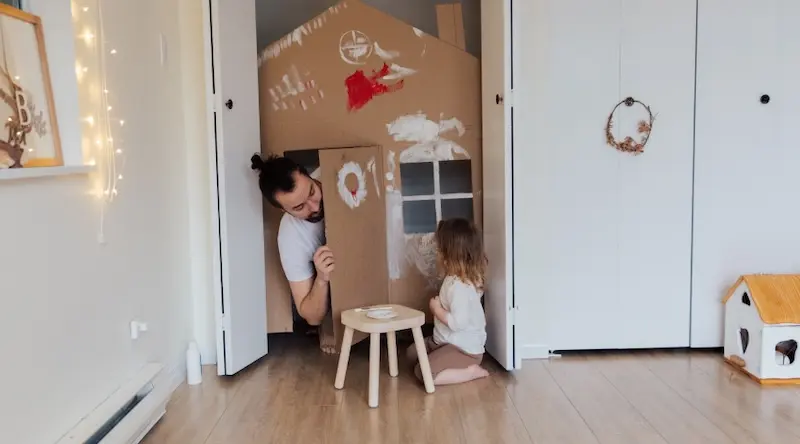settings
children
With Famly since
It’s no mystery that the children at your child care setting learn best when adults help create a good structure for growth.
But isn’t it time we acknowledge that the grown-ups at a child care setting could also use a bit of help now and then?
The National Association for the Education of Young Children (NAEYC) states that quality education happens when educators create a caring community of learners, enhance development and learning, plan an appropriate curriculum, and assess development and growth.
The fact is, we’re growing and learning our whole lives long — so the grown-ups at your child care center need support too.
But when teachers are so busy creating a great learning environment for children, we can’t expect them to have time to structure their own learning, too.
That’s where the early years team leaders come in.
When our child care team leaders give educators the same support and care we expect them to give to young children, our entire child care community gets stronger.

The role of an education leader
In leadership workshops, I ask audiences to describe the characteristics of a good toddler teacher. These words and traits often come up:
- Flexible
- Sensitive
- A good sense of humor
- Organized chaos
- Stamina
- Resourceful
- Caring
But teachers aren’t the only ones on the child care team with these traits. When you think about it, the skills that make a good early years teacher are the same ones that make a great early years leader.
There’s a parallel here: We can use many of the techniques for supporting young children to help our team members grow and thrive at their own job.
In most child care centers, the managers and directors started as teachers, who were then selected or self-identified as leaders. This means that as a leader, you’ve already got the teaching skills, so you’ve got a toolbox of techniques you already know to lead your program.
The benefits are all around: Your staff feels respected and valued, the children and families get even better care, and you have more cooperation, growth and satisfaction in your team. All this is a recipe for a well-organized program with great retention and happy parents.
Children and adults deserve an enabling environment
In a good classroom, teachers intentionally arrange the environment for children to get along and play together. They establish routines, make sure there are enough toys to share, and they remind the children of the rules of behavior. The message is, “we’re all in this together”.
Just as we create the conditions for growth for children, education leaders can do the same for their team. They do that with:
- Caring behavior
- Fair working conditions
- Good communication
- Professional resources
- Positive and constructive feedback.
They remind their educators that even though some days are challenging, you can count on your leader to support you in doing a good job. Let’s get into how leaders can put these ideas into daily practice.

Create a caring community
An Early Years program is a place where children, families, and staff interact intimately. “Henry’s grandma died yesterday; Bobby has a new baby sister; My husband is getting a new job, we have to move; Emma didn’t sleep well last night, I think she’s teething.”
Every day, educators absorb lots of big and small news about the families’ private lives. In order to be available to children, educators need to replenish their own supply of emotional strength.
When a smiling director greets them every morning, asks how they are and listens, she creates a caring environment. She is modeling enthusiasm for the work of educating children. Even just a positive comment goes a long way: “Julie, good to see you today! I notice you are reading The Hungry Caterpillar at circle time, fun book. Let me know how it goes.”
It might feel small, but bundled up in that comment is a lot of care and attention: It shows you’re interested in the work your team does, you pay attention to it and you value it.
Affirm educators’ skills and self
When every day in child care is so busy, it can be hard for teachers to have the time to reflect on their own work, and how they’re doing. That’s why your teachers’ sense of competence and skill needs support, just like children’s sense of self and development.
As a leader, you can be the mirror that affirms educators’ value. It can even be a simple compliment: “Peter, you did a good job helping Alex and his mom separate this morning. She looked reassured when she left.”
You can do these affirmations verbally or in writing. And if you notice some things are not going well, you should also give feedback on that. But then, it must be coupled with individual support — such as coaching and professional development. Remember, it’s about giving your team the resources to learn and grow.
Professional development is not one-size-fits-all. While all your staff may need training on teaching early literacy, some educators may be more advanced than others. So, you would fine tune the resources, as you expect them to individualize instruction for the children.
Communicate clearly and often
In a well-run classroom, we see teachers giving clear directions to children every day, even for routine activities: “Okay children, remember it’s time to go to lunch now. First go wash your hands, then find the placemat with your name on it, and sit in your spot.” You might use a variety of methods for communication such as singing or counting. This helps certain children who might be a bit distracted.
Why say the same thing several times, and in different ways? It’s because every child communicates in different ways, so we’ve got to make sure we reach everyone.
The exact same idea applies with the grown-ups on your team.
Just because you say something once, not everyone gets it. Some people might do great face-to-face, others might really prefer a text message for those important updates. Alternate the ways to communicate, such as by text, email, in person, in large groups, and individually. Whether you are presenting a new curriculum or want to ensure safe procedures for washing of toys, plan to tailor and repeat your message so everyone hears it clearly.

Help teachers grow
Intentional teachers assess children’s skills and design their instruction accordingly. You understand where children are at, and propose the next steps for growth. For a toddler teacher, it may be getting her little ones to practice fine motor skills with big crayons. She proposes activities that are safe and help children grow, building a scaffold for their learning.
But scaffolded learning isn’t just for children. Teaching is a skill, and not all educators are at the same level. That’s okay — because as a leader, you’re there to help everyone grow.
You may already know of excellent tools to assess the classroom that give objective feedback to the teacher and you. When the teacher does a self-assessment and you do the appropriate observations, then you can both have a productive, professional conversation that helps you decide what’s working and what’s not. Your job is to scaffold the skills of the teacher with professional support and resources specific to the situation.
Remember, this draws on the same patience and empathy teachers should show young learners. You’re not blaming educators for not knowing something, you’re helping them grow in their abilities.
Trust your own good skills
We expect educators to analyze and reanalyze their approach with children, to make sure everyone’s able to learn at their best. It’s important for leaders to reflect on their approach, too.
In my work, I’ve observed that managers, directors, or principals may hyper-focus their attention on children’s learning. They want the children to do well, but they bypass the medium by which children learn — the educators themselves.
If our ultimate goal is children’s growth,the first goal should be the well-being and functioning of the people who make that possible. If you want your staff to be caring, competent, intentional, and collaborative, think of yourself as that good toddler teacher. You already know what to do.
Angèle Sancho Passe is a writer and early education consultant based in Minneapolis, Minnesota. She cares deeply about teaching children and as much about supporting education leaders and teachers. You can learn more at www.angelesanchopasse.com.
The big ideas
Your personal writing assistant
Fix spelling, grammar, and improve the tone of every message and newsfeed post. All with Sidekick.
Learn how Sidekick works






%20(2).png)

.jpg)

